Homeless youth and students are a vulnerable population making up three percent of California’s students (2023–24 Census data). This page contains the state level educational outcomes and enrollment data for the homeless youth population. Resources and frequently asked questions are also available to support local educational agencies, homeless liaisons, and homeless student advocates.
Homeless Education's Laws and Definitions
This tab provides information about the McKinney-Vento Act as well as terms related to the homeless student group population specific to the California Department of Education (CDE). For more information and resources for homeless children and youth, visit the CDE Homeless Education web page.
McKinney-Vento Law
The McKinney-Vento Homeless Assistance Act (McKinney-Vento Act
 ) (42 U.S.C. § 11431-11435) is federal legislation that ensures the educational rights and protections of children and youth experiencing homelessness. It requires all local educational agencies (LEAs) to ensure that homeless students have access to the same free, appropriate public education, including public preschools, as provided to other children and youth. The McKinney-Vento Act defines LEAs as public school districts, direct-funded and locally funded charter schools, and county offices of education.
) (42 U.S.C. § 11431-11435) is federal legislation that ensures the educational rights and protections of children and youth experiencing homelessness. It requires all local educational agencies (LEAs) to ensure that homeless students have access to the same free, appropriate public education, including public preschools, as provided to other children and youth. The McKinney-Vento Act defines LEAs as public school districts, direct-funded and locally funded charter schools, and county offices of education.
Definitions of Homelessness
The McKinney-Vento Act defines homeless children and youth as individuals who lack a fixed, regular, and adequate nighttime residence. This definition also includes:
- Children and youth who are sharing the housing of other persons due to loss of housing, economic hardship, or a similar reason; are living in motels, hotels, trailer parks, or camping grounds due to the lack of alternative adequate accommodations; are living in emergency or transitional shelters; or are abandoned in hospitals;
- Children and youth who have a primary nighttime residence that is a public or private place not designed for or ordinarily used as a regular sleeping accommodation for human beings;
- Children and youth who are living in cars, parks, public spaces, abandoned buildings, substandard housing, bus or train stations, or similar settings;
- Migratory children who qualify as homeless for the purposes of this subtitle because the children are living in circumstances described in clauses (i) through (iii)
Related Definitions
California Longitudinal Pupil Achievement Data System (CALPADS)
CALPADS is a student-level data system that includes student demographics, course data, discipline, assessments, staff assignments, and other data for state and federal reporting. For more information visit the CALPADS web page.
California School Dashboard (Dashboard)
The Dashboard
 contains reports that display the performance of local educational agencies (LEAs), schools, and student groups on a set of state and local measures to assist in identifying strengths, challenges, and areas in need of improvement.
contains reports that display the performance of local educational agencies (LEAs), schools, and student groups on a set of state and local measures to assist in identifying strengths, challenges, and areas in need of improvement.
Census Day
Census Day is the first Wednesday in October, also known as Information Day when annual enrollment data are submitted by LEAs to the CDE through CALPADS.
Consolidated Application and Reporting System (CARS)
CARS is a data collection system to apply for Categorical Program Funding and to report on the use of those funds. For more information visit the CARS web page.
Cumulative Enrollment
The cumulative enrollment data includes an unduplicated count of all students who had a primary or short-term enrollment for at least one day at any time within the academic school year (July 1 to June 30).
Enroll and Enrollment
Enroll and enrollment means a student is signed up to attend classes and participate fully in school activities.
Immediate Enrollment
Immediate Enrollment is when a homeless student is entitled to immediately enroll in any public school that students in the same area are eligible to attend; even if: students have missed application or enrollment deadlines during any period of homelessness or students do not have required documents, such as school records, records of immunization and other required health records, proof of residency, guardianship, or other documents.
Homeless Youth
Homeless youth is defined as children and youth who lack a fixed, regular, and adequate nighttime residence.
Housing Type
- Hotels/Motels means living in a hotel or motel due to not having a fixed, permanent residence.
- Temporarily Doubled-Up means living with relatives or friends, due to economic hardship (including unaccompanied youth and runaways).
- Temporary Shelters means living in transitional housing.
- Temporarily Unsheltered* means living in abandoned buildings, campgrounds, vehicles, trailer parks, Federal Emergency Management Agency (FEMA) trailers, bus and train stations, or is abandoned in the hospital.
- *Unsheltered is also defined as substandard or inadequate housing and is judged on a case-by-case basis. A rule of thumb would be to see the dwelling as comparable to an automobile, in that it shelters, yet it is not adequate housing.
Local Control Funding Formula (LCFF)
The LCFF establishes uniform grade span grants in place of the myriad of previously existing K–12 funding streams, including revenue limits, general-purpose block grants, and most state categorical programs (see School District and Charter School LCFF Entitlement). For county offices of education (COEs), the LCFF establishes funding for oversight activities and instructional programs (see County Office of Education LCFF Entitlement).
Reporting Requirements
All LEAs are required to report the number of homeless students enrolled during a school year through CALPADS and the Annual Homeless Survey.
Residence Type
- Fixed residence is one that is stationary, permanent, and not subject to change.
- Regular residence is one that is used on a normal, standard, and consistent basis.
- Adequate residence is one that is sufficient for meeting both the physical and psychological needs typically met in home environments.
School of Origin
School of origin is defined as the school that a child or youth attended when permanently housed, the school in which the child or youth was last enrolled when they became homeless, or a school that the child or youth has had some sort of connection to within the last 15 months.
School Stability
School stability measures whether a student is enrolled in the same school for an entire school year without a break in enrollment.
Socioeconomically Disadvantaged
The Socioeconomically Disadvantaged student group is comprised of students who meet at least one of the following criteria:
- neither of the student's parents has received a high school diploma
- the student is eligible for or participating in the Free Meal program or Reduced-Price Meal program
- the student is eligible for or participating in the Title I Part C Migrant program
- the student was considered Homeless
- the student was Foster Program Eligible
- the student was Directly Certified
- the student was enrolled in a Juvenile Court School
- the student is eligible as a Tribal Foster Youth
For more information visit the LCFF Equity Multiplier web page.
Unaccompanied Homeless Youth
Unaccompanied Homeless Youth is defined as a youth that is not in the physical custody of their parent or guardian and meets the definition of homelessness, as stated above.
Quick Facts Data
This tab provides quick facts about homeless students. Please visit the Homeless Children and Youth Data web page to access data reports, downloadable files, and data resources specifically for homeless youth.
Census Day Statewide Homeless Student Enrollment Chart
Data Source: Enrollment by Subgroup for Charter and Non-Charter Schools which consists of the number of students enrolled on the first Wednesday in October.
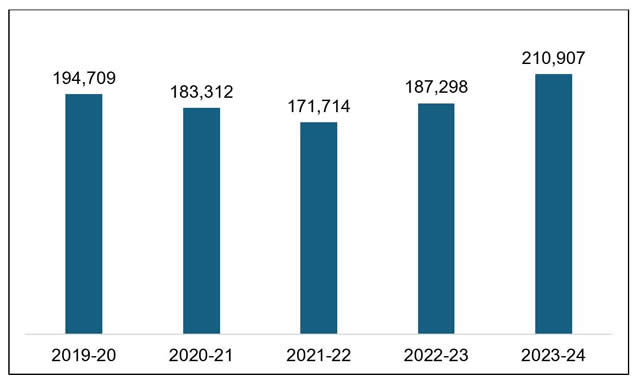
Census Day Statewide Homeless Student Enrollment Table
Data Source: Enrollment by Subgroup for Charter and Non-Charter Schools which consists of the number of students enrolled on the first Wednesday in October.
| Academic Year |
Total Homeless Enrollment |
| 2023–24 |
210,907 |
| 2022–23 |
187,298 |
| 2021–22 |
171,714 |
| 2020–21 |
183,312 |
| 2019–20 |
194,709 |
| 2018–19 |
207,677 |
Cumulative Statewide Homeless Student Enrollment Chart
Data Source: Homeless Student Enrollment by Dwelling Type which consists of the total number of unduplicated primary and short-term enrollments within the academic year (July 1 to June 30), regardless of whether the student is enrolled multiple times within a school or district.
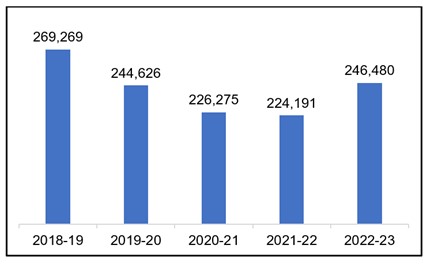
Cumulative Statewide Homeless Student Enrollment Table
Data Source: Homeless Student Enrollment by Dwelling Type which consists of the total number of unduplicated primary and short-term enrollments within the academic year (July 1 to June 30), regardless of whether the student is enrolled multiple times within a school or district.
| Academic Year |
Total Homeless Enrollment |
| 2022–23 |
246,480 |
| 2021–22 |
224,191 |
| 2020–21 |
226,275 |
| 2019–20 |
244,626 |
| *2018–19 |
269,269 |
* The 2018-19 cumulative enrollment data can be found in the Suspension Rate report on DataQuest.
2022–23 Homeless Enrollment by Dwelling Type
Data Source: Suspension Rate Homeless Student Enrollment by Dwelling Type report.
| Homeless Student Dwelling Type |
Percent of Students |
Number of Students |
| Temporarily Doubled-Up |
83.3% |
205,265 |
| Temporary Shelters |
6.9% |
17,026 |
| Hotels/Motels |
6% |
14,733 |
| Temporarily Unsheltered |
3.8% |
9,451 |
2022–23 Homeless Unaccompanied Youth by Grade Enrollment
Data Source: Suspension Rate report on Homeless Student Enrollment by Dwelling Type which consists of the total number of unduplicated primary and short-term enrollments within the academic year (July 1 to June 30), regardless of whether the student is enrolled multiple times within a school or district.
Unaccompanied youth enrollment increased by 1,374 students in 2022-23 as compared to the 2021-22 school year.
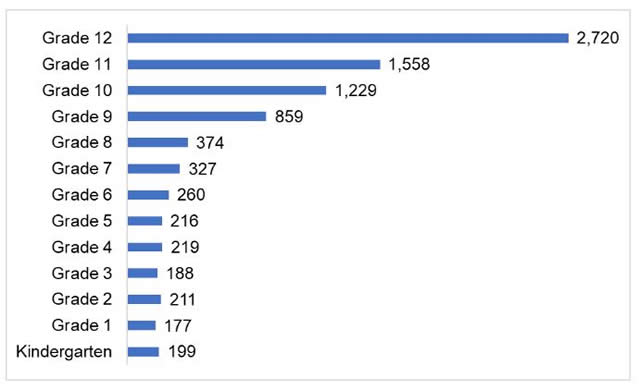
2022-23 Homeless Unaccompanied Youth by Grade Enrollment Table
Data Source: Homeless Student Enrollment by Dwelling Type, which consists of the total number of unduplicated primary and short-term enrollments within the academic year (July 1 to June 30), regardless of whether the student is enrolled multiple times within a school or district.
| Grade |
Number of Unaccompanied Youth |
| Kindergarten |
199 |
| Grade 1 |
177 |
| Grade 2 |
211 |
| Grade 3 |
188 |
| Grade 4 |
219 |
| Grade 5 |
216 |
| Grade 6 |
260 |
| Grade 7 |
327 |
| Grade 8 |
374 |
| Grade 9 |
859 |
| Grade 10 |
1,229 |
| Grade 11 |
1,558 |
| Grade 12 |
2,720 |
State Level Educational Outcomes of Homeless Students
This tab provides state level educational outcomes for homeless students, which are published annually on DataQuest.
DataQuest is the California Department of Education’s online, public reporting system that provides reports about California’s schools and school districts.
To find out how to access reports specifically for homeless youth, visit the Homeless Children and Youth Data web page.
2023-24 Percent of Students Chronically Absent
The graph below displays the 2023–24 school year chronic absence rates for TK-12 non-homeless students, 19.6 percent, and homeless students, 36.3 percent.
The chronic absence rate is calculated as the percent of students who miss ten percent or more of the days they are expected to attend. This report is available through Chronic Absenteeism Rate.
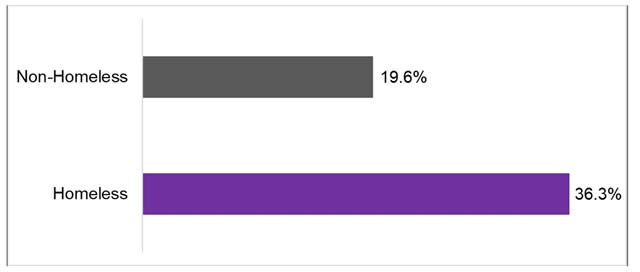
2023–24 Suspension Rate
The graph below displays the 2023–24 school year suspension rates for TK-12 non-homeless students, 3.2 percent, and homeless students, 5.8 percent.
Suspension rate is calculated as the percent of all students who were suspended one or more times during the school year for an
in-school or out-of-school suspension. This report is available through Expulsion and Suspension Data.
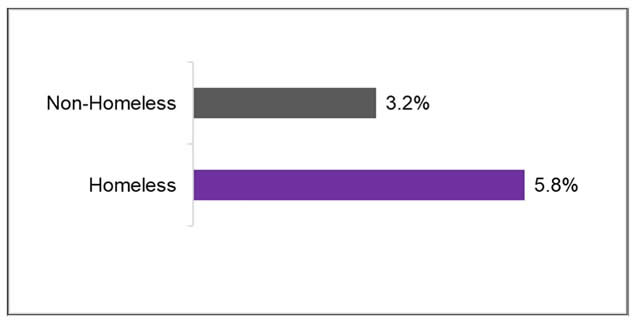
2023–24 Stability Report
The stability rates are from a new report that provides a total count of cumulatively enrolled students with an enrollment start date on or after July 1 and on or before June 30 (Adjusted Cumulative Enrollment), a count of students identified as part of the Stability Count (i.e., students with stable enrollments), and a count of students identified as part of the Non-Stability Count (i.e., students without stable enrollments). Students are determined to have a “stable” enrollment during the academic year if the enrollment record is a minimum of 245 consecutive calendar days at the same school without a disqualifying exit. The Adjusted Cumulative Enrollment along with the Stability and Non-Stability Count are used to calculate the Stability Rate (Stability Count divided by the Adjusted Cumulative Enrollment) and the Non-Stability Rate (Non-Stability Count divided by the Adjusted Cumulative Enrollment) at the selected entity for the selected population using the available filters. This report is available through Stability Report.
The graph below displays the 2023–24 Stability Rate for TK-12
non-homeless students, 91.8 percent, and homeless students, 74.4 percent.
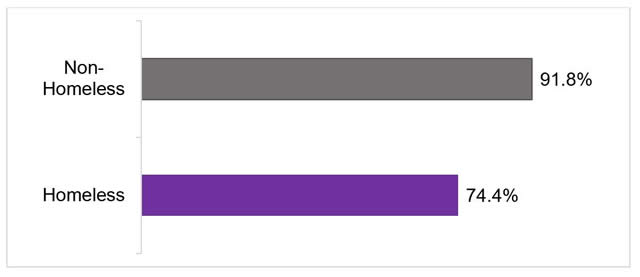
2023–24 Four-Year Cohort Graduation Rate
The graph below displays the 2023–24 school year four-year cohort graduation rates for non-homeless students, 87.4 percent, and homeless students, 74.6 percent. The four-year cohort graduation rate is calculated as the percent of students who graduate high school within four years from the time they
enter ninth grade with a traditional high school diploma. This report is available through Four-Year Adjusted Cohort Graduation Rate.
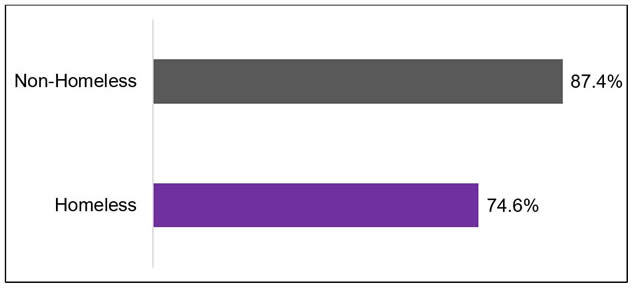
2023–24 Graduates Receiving a Local Requirements Exemption
The Graduates Receiving a Local Requirements Exemption is a new indicator that shows graduating high school students who completed all state graduation requirements for a standard high school diploma but were exempt from local graduation requirements. For 2023-24, 10.1 percent of homeless youth students graduated with an exemption from local graduation requirements compared to 1.2 percent of non-homeless students. The Graduates Receiving a Local Requirements Exemption report can be found under the Four-Year Adjusted Cohort Graduation indicator and accessed through DataQuest.
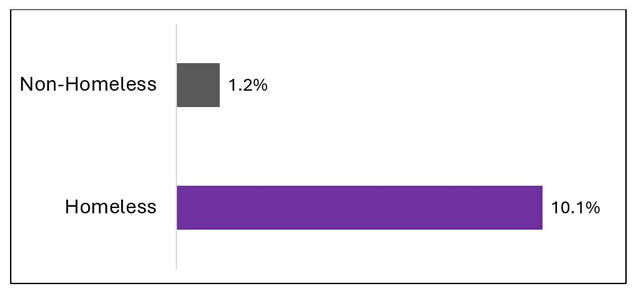
2023–24 Four-Year Cohort Dropout Rate
The graph below displays the 2023–24 school year four-year cohort dropout rates for non-homeless students, 8.2 percent and homeless students, 16.8 percent. The four-year cohort dropout rate is calculated as the percent of cohort students who (1) do not graduate with a regular high school diploma, (2) do not otherwise complete high school, or (3) are not still enrolled as a "fifth-year senior." The report is available through Four-Year Adjusted Cohort Outcome.
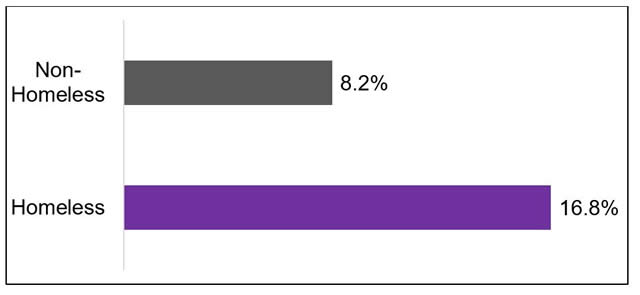
State Level Accountability for Homeless Youth
This tab provides the latest statewide accountability indicators for homeless youth.

California's accountability system is a multiple measures system that assesses how local educational agencies (LEAs) and schools are meeting the needs of their students. Performance on these measures is reported through the California School Dashboard and System of Support.
The 2023–24 California School Dashboard (Dashboard), reflects California’s accountability system with Performance Levels (or colors) for state indicators, which are determined using current year performance (or Status) and the difference from prior year (or Change) to show growth or decline. This results in five color-coded Performance Levels for each indicator. From highest to lowest, the Performance Levels are: Blue, Green, Yellow, Orange, and Red. For more information, please visit the Five-By-Five Colored Tables web page.
The 2023–24 accountability measures and historical homeless performance can be found on California School Dashboard
 .
.
For more information, resources, and guidance for the Dashboard and System of Support, please visit the California School Dashboard and System of Support web page.
English Language Arts
This measure of the Academic Performance state indicator reports student progress on the statewide assessment for English Language Arts/Literacy (ELA). It uses the Smarter Balanced Summative Assessments and California Alternate Assessments, and it is calculated based on the average "Distance from Standard" for all students in grades 3 through 8 and/or grade 11. The homeless student group has ‘Red’ performance level, maintained with -2.5 points and scored 70.4 points below standard compared to the statewide average of 13.2 points below standard for all students. This data is available on the Dashboard English Language Arts .
.
Number of Students: 119,419
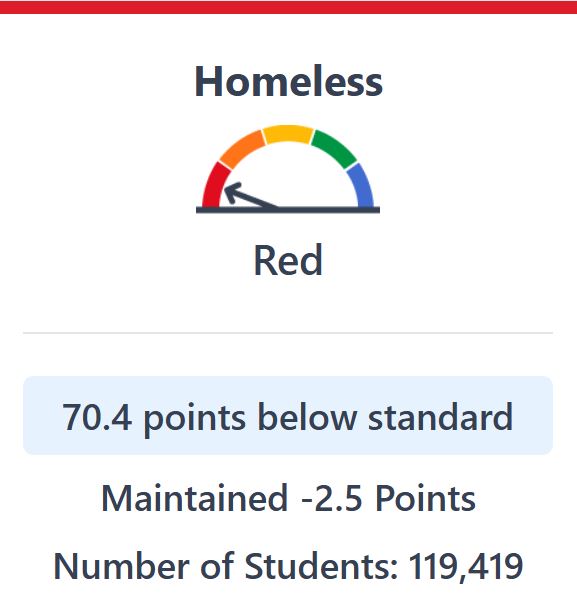
Mathematics
This measure of the Academic Performance state indicator reports student progress on the statewide assessment for mathematics. It uses the Smarter Balanced Summative Assessments and California Alternate Assessments, and it is calculated based on the average "Distance from Standard" for all students in grades 3 through 8 and/or grade 11. The homeless student group has a ‘Red’ Performance level, ‘Declined’ the level by 4.7 points, and scored 106 points below standard compared to the stateside average of 47.6 points below standard for all students. This data is available on the Dashboard Mathematics .
.
Number of Students: 128,657
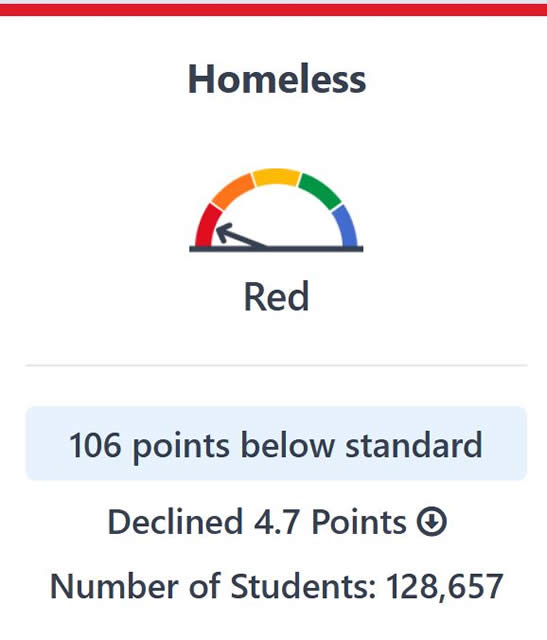
Chronic Absenteeism
The Chronic Absenteeism state indicator shows how many students were absent for 10 percent or more of the total instructional school days each student was expected to attend. The homeless youth student group has a ‘Yellow’ performance level and ‘Declined’ by 6.4 percent. 32.7 percent of homeless students in transitional kindergarten through eighth grade were chronically absent in the 2023–24 school year compared to the statewide rate of 18.6 percent for all students. This data is available on the Dashboard Chronic Absenteeism .
.
Number of Students: 193,916
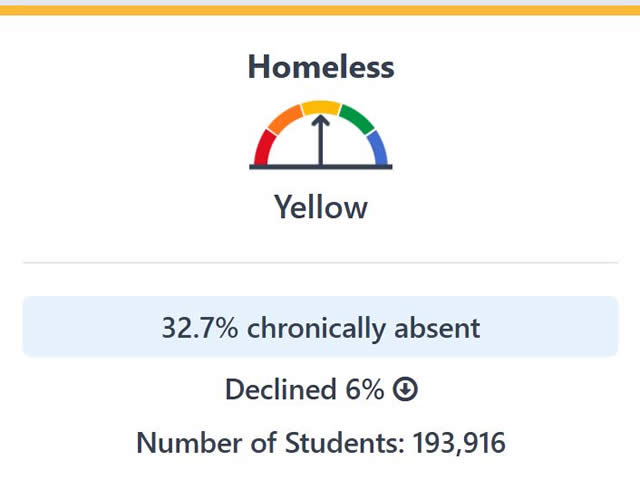
Graduation Rate
The Graduation Rate state indicator reflects the number of students who graduate with a regular high school diploma in four years or five years. The homeless youth student group has a ‘Yellow’ performance level and ‘Increased’ 2 percent. 75.7 percent of homeless students graduated in the 2023–24 school year compared to the statewide rate of 86.7 percent for all students. This data is available on the Dashboard Graduation Rate .
.
Number of Students: 39,280
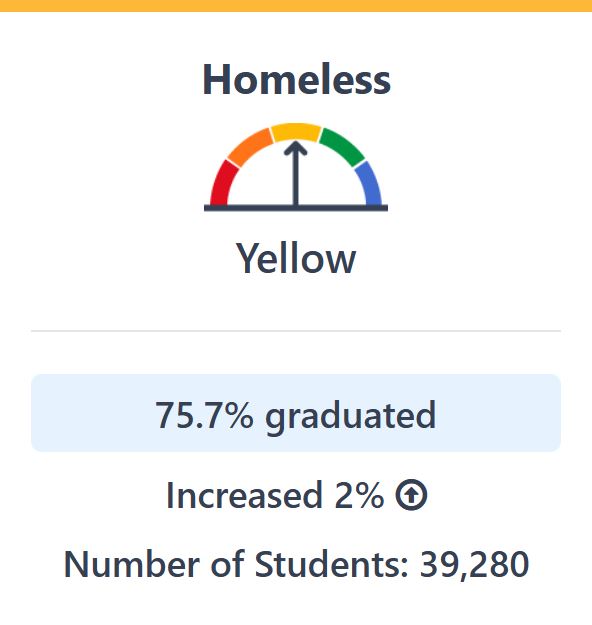
College/Career
The College/Career Readiness state indicator shows how many students graduate from high school better prepared for college or a career. It uses many different college and career measures, such as completion of coursework, work experience, and exam results. The homeless youth student group has an ‘Orange’ performance level and ‘Maintained’ 1.3 percent. 21.8 percent of the homeless youth student group graduated from high school prepared for college or a career compared to the statewide rate of 45.3 percent for all students. This data is available on the Dashboard College/Career .
.
Number of Students: 37,772
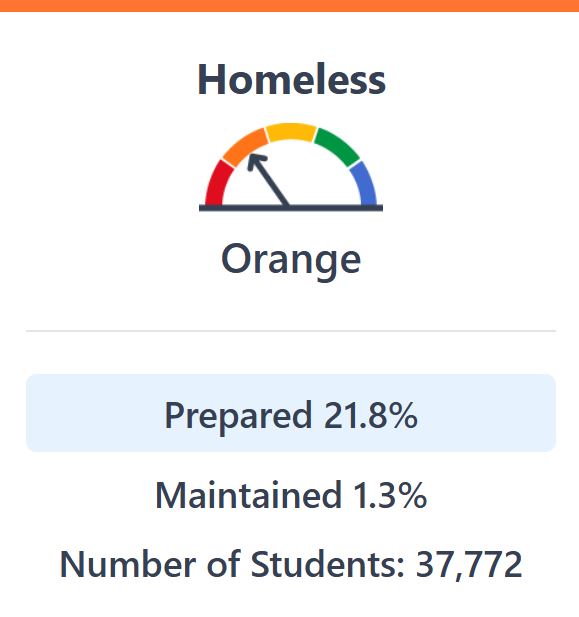
Suspension Rate
The Suspension Rate state indicator reflects the percentage of students in transitional kindergarten through grade 12 who have been suspended at least once in a given school year. Students who are suspended multiple times are only counted once. The homeless youth student group has a ‘Yellow’ performance level and ‘Declined’ by 0.8 percent. 5.7 percent of the homeless student group were suspended for at least one day compared to the statewide rate of 32 percent for all students. This data is available on the Dashboard Suspension Rate .
.
Number of Students: 286,821
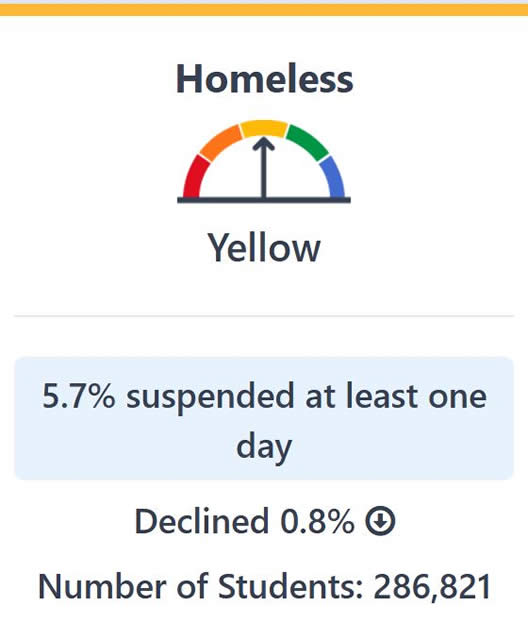
Geographic Information System (GIS)
This tab provides access and information for the Homeless Census Day Enrollment by School District
 and Homeless Enrollment Change by District Geographic Information System (GIS) Map. GIS software allows users to create, manage, analyze, and visualize data via a geographic display.
and Homeless Enrollment Change by District Geographic Information System (GIS) Map. GIS software allows users to create, manage, analyze, and visualize data via a geographic display.
Homeless Census Day Enrollment by School District
The Homeless Census Day Enrollment by School District map is an interactive tool which displays how California’s student homeless population varies geographically throughout the state. The map shows the locations of California’s public school districts linked to district-level student enrollment counts.
Each circle represents a school district and when selected, district directory information will appear along with the homeless percentage, homeless enrollment, and district enrollment. The circle size corresponds to the count of homeless students enrolled. A set of interactive data filters on the left pane enable the user to limit the display of school districts. The map and summary statistics on the right pane update automatically when a filter is applied.
Homeless Enrollment Change by District
On the bottom left corner of the Homeless Census Day Enrollment by School District
 map you can open the change map by selecting the “Homeless Enrollment Change by District” icon. This change map displays the difference in homeless enrollment between the two most recent years of data.
map you can open the change map by selecting the “Homeless Enrollment Change by District” icon. This change map displays the difference in homeless enrollment between the two most recent years of data.
Changes in enrollment between the previous and current school years are represented with orange and purple circles. Orange circles indicate an increase in homeless student enrollment from the prior school year and purple circles indicate a zero or decrease in homeless student enrollment from the previous school year. The size of the circle represents the scope of change in homeless student enrollment.
Student Data
The student data in this application is reported at the school district level and is based on Census Day enrollment counts, which are collected on the first Wednesday in October of each academic year. This information was submitted by local educational agencies (LEAs) and charter schools to the California Department of Education (CDE) as part of the annual Fall 1 data submission in the California Longitudinal Pupil Achievement Data System (CALPADS). You can access the full Census Day Enrollment reports at this link, DataQuest Annual Enrollment.
Please Note: There is no downloadable data file associated with this map; however, you can copy and paste the district list into a spreadsheet.
Data Filters
Data filters are used to limit the display of school districts. Filter options include district, school year, homeless enrollment count, homeless percent, and charter status, all of which can be used simultaneously. Only school districts that meet the defined conditions will be displayed on the map.
Academic Year
The academic year is the school year when the student data was collected. The two most recent school years, 2022–23 and 2023–24 are available to view on this map.
Homeless Count
The Homeless Count is the total enrollment count of K-12 students experiencing homelessness on Fall Census Day (the first Wednesday in October) in the academic year selected. A slide feature allows the user to adjust the desired enrollment count and percentage with fewer students on the left and more students on the right. The size of the enrollment count will be reflected in five distinct symbol sizes, with the smallest being 0 to 25 and the largest being 1,001 to 9,410.
Homeless Percent
The homeless percent is the percent of K-12 students enrolled who were experiencing homelessness on Fall Census Day (first Wednesday in October) in the academic year selected.
Homeless by Charter Status
The Charter Status filter allows users to view homeless student enrollment with three different filter selections. Users can view enrollments for all schools within a district, only charter schools within a district, or only non-charter schools within a district. For more information about charter schools please visit CDE’s Charter School web page.
Filter Districts by County
A county list and search tool can be found in the top right corner of the map. Once a desired county is selected, the map will only show districts within the selected county, and a district list with corresponding homeless student enrollment data will appear on the right-side column. For more information about school districts in California, please visit the California School Directory.
Resources
This tab provides resources specific to the needs and outcomes of homeless children and youth.
Educational Support Services
Data
- Homeless Census Day Enrollment by School District GIS Map

Homeless Enrollment Change by District Geographic Information System (GIS) Map. GIS software allows users to create, manage, analyze, and visualize data via a geographic display.
- Homeless Children and Youth Data
This page provides access to information and DataQuest reports for California's homeless children and
youth.
- Accessing Educational Data
This page provides access to data collected by the California Department of Education (CDE), including enrollment data,
demographic and student group data, staff data, school and district accountability, statewide assessment results, and directory information.
- Homeless Data Collection Timeline
The page provides data collection timelines for California Longitudinal Pupil Achievement Data System (CAPLADS) and Consolidated Application and Reporting System (CARS).
- Data Crosswalk for the California School Dashboard and DataQuest (DOCX)
This Data Crosswalk document provides a short overview of the differences in the way that data are produced for DataQuest and the California School Dashboard.
External Websites
Frequently Asked Questions
The sections below address the most commonly asked questions about homeless student data.
Identification | Data Collection | Data Certification
Identification
A student is determined homeless if they lack a fixed, regular, and adequate nighttime residence. Examples of homelessness include children and youth living in:
- Shared housing due to economic hardship, loss of housing, or natural disasters
- Motels or hotels
- Public or private places not designed for sleeping
- Trailer parks or campgrounds
- Cars, parks, and abandoned buildings
- Shelters
- Emergency or transitional shelter
Yes. If a student was homeless at any time between July 30 to June 1, they will still be considered homeless.
Under the Local Control Funding Formula (LCFF), any student identified for free or reduced-price meals (FRPM) are included in the schools’ socioeconomically disadvantaged accountability subgroup. Homeless students automatically qualify for FRPM, and therefore, generate LCFF funds for local educational agencies (LEAs). In addition, homeless students are automatically eligible for Title I services, regardless of their current academic performance.
- Ensure every student who enrolls fills out the School Housing Questionnaire(PDF).
- Ensure homeless student data is properly entered in the Student Information System (SIS) and California Longitudinal Pupil Achievement Data System (CALPADS) 5.4/ 5.5.
- Ensure all school faculty and personnel are trained to identify when a student is homeless.
- Attend Identification webinars offered by California Department of Education (CDE) and local educational agencies (LEA's).
- Identifying Children and Youth in Homeless Situations(PDF)
- This National Center for Homeless Education (NCHE) brief summarizes the key provisions of the McKinney-Vento Act related to the identification of children and youth experiencing homelessness, and provides an overview of implementation strategies at the state and local level.
Yes. Homelessness should be verified at the beginning and at the end of each school year to ensure students are appropriately counted for Local Control Funding Formula (LCFF) purposes. If a student is still homeless, no change is necessary; however, if a student is no longer homeless, be sure to populate the program end date to prevent students from inaccurately being reported as homeless.
The California Department of Education (CDE) developed a sample Housing Questionnaire and it is a highly recommended best practice to assist local educational agencies (LEAs) with the identification of homeless children and youth. The Education for Homeless Children and Youth program states that all LEAs and their homeless liaisons must ensure that homeless children and youth are identified by school personnel through outreach and coordination with other agencies.
LEAs are defined as county offices of education (COEs), school districts, and charter schools.
LEAs need to take a proactive approach to identify homeless children and youth. It is the first step to connecting these students and their families with information, resources, and supports necessary to ensure that they have equal access to the same free, appropriate public education, including public preschool education, as is provided to other children and youth.
You can access the Housing Questionnaire sample as well as guidance on completing it on the CDE’s Resources for Homeless Children and Youth website.
Data Collection
CALPADS needs to be updated on Census Day (First Wednesday in October) and at least once in the academic year (if the student was not homeless on Census Day, but was homeless sometime in the academic year). Although not required, local education agency (LEAs) are strongly encouraged to regularly update data in CALPADS throughout the academic year to ensure youth are correctly identified as homeless.
Homeless data are collected continually throughout the school year and are certified twice a year: once during Fall 1 certification window and once during the End of Year 3 (EOY3) certification window. Local education agency (LEAs) are strongly encouraged to regularly update data in CALPADS throughout the academic year to ensure youth are correctly identified as homeless. Refer to the CALPADS Calendar for submission windows and certification deadlines.
Local education agency (LEAs) should submit a homeless program record for infant, toddler, and pre-K children who are enrolled in CALPADS and who are homeless, as these students are included in all homeless reports in CALPADS. For more information refer to the CALPADS Data Guide(DOCX; Dated 14-Feb-2020).
The CARS is a data collection system to apply for Categorical Program Funding and to report on the use of those funds. CALPADS collects homeless enrollment information. CALPADS is a data reporting system through which LEAs report specific data used to determine Local Control Funding Formula (LCFF) funding allocations and to calculate educational outcomes.
Temporary Doubled Up, Temporary motel/Hotel, Temporary Sheltered, Temporary Unsheltered. For more details, please see the Definitions section.
There is no statewide average.
Data Certification
Homeless student data are certified two times a year in CALPADS. The Fall 1 submission is certified in late January and early February and End of Year 3 (EOY 3) submission is certified in late August.
In order to certify data in CALPADS, authorized district or charter school personnel are required to review the accuracy of all data associated with the applicable CALPADS submission. CALPADS certification is a two-step process with Level-2 certification reserved. Refer to the CALPADS Calendar for the submission windows and certification deadlines.
The California School Dashboard (Dashboard) provides data on school and district progress so they can participate in decisions to improve student learning. DataQuest provide data and statistics about California’s K–12 public educational system that supports a wide variety of informational, research, and policy needs. Summary and detailed data reports are available for multiple subject areas at the school, district, county, and state levels.
(Dashboard) provides data on school and district progress so they can participate in decisions to improve student learning. DataQuest provide data and statistics about California’s K–12 public educational system that supports a wide variety of informational, research, and policy needs. Summary and detailed data reports are available for multiple subject areas at the school, district, county, and state levels.
For more information on the differences between the California School Dashboard and DataQuest please visit Data Crosswalk for the California School Dashboard and DataQuest(DOCX).
Cumulative enrollment data includes an unduplicated count of all students who had a primary or short-term enrollment for at least one day anytime within the school year (July 1 to June 30). Cumulative enrollment data can be found on California Department of Education's (CDE's) Cumulative Enrollment Data website. Annual enrollment (Census Day enrollment) consists of the number of students enrolled on Census Day (the first Wednesday in October). Census Day enrollment data can be found on CDE's Annual Enrollment website.
In order to access and review C/A Report 5.4, a CALPADS user must have the County role added to their CALPADS account.
![]() ) (42 U.S.C. § 11431-11435) is federal legislation that ensures the educational rights and protections of children and youth experiencing homelessness. It requires all local educational agencies (LEAs) to ensure that homeless students have access to the same free, appropriate public education, including public preschools, as provided to other children and youth. The McKinney-Vento Act defines LEAs as public school districts, direct-funded and locally funded charter schools, and county offices of education.
) (42 U.S.C. § 11431-11435) is federal legislation that ensures the educational rights and protections of children and youth experiencing homelessness. It requires all local educational agencies (LEAs) to ensure that homeless students have access to the same free, appropriate public education, including public preschools, as provided to other children and youth. The McKinney-Vento Act defines LEAs as public school districts, direct-funded and locally funded charter schools, and county offices of education. ![]() contains reports that display the performance of local educational agencies (LEAs), schools, and student groups on a set of state and local measures to assist in identifying strengths, challenges, and areas in need of improvement.
contains reports that display the performance of local educational agencies (LEAs), schools, and student groups on a set of state and local measures to assist in identifying strengths, challenges, and areas in need of improvement.
